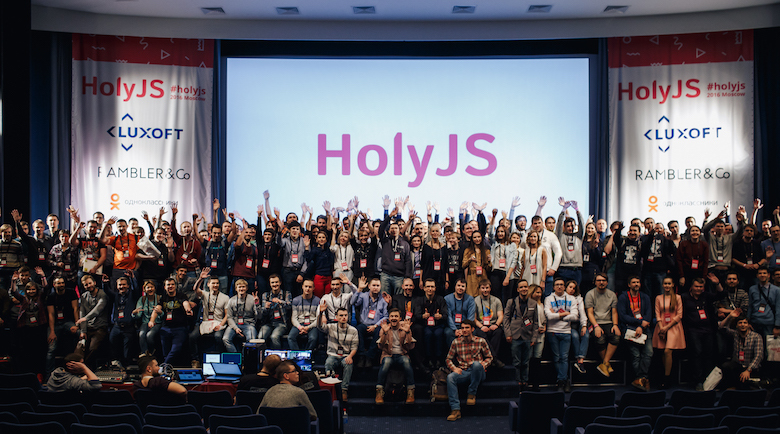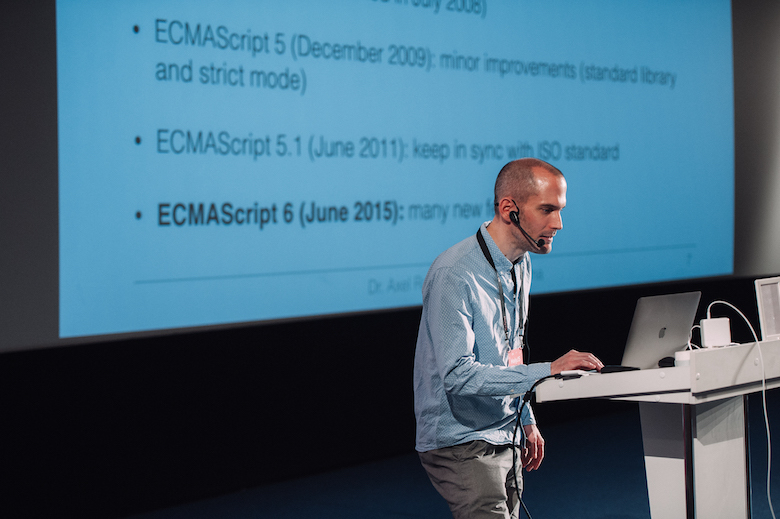HolyJS Moscow: Expansion Time

JavaScript-world is developing so rapidly that even half a year between St. Petersburg and Moscow HolyJS a lot has happened: for example, in the summer nobody knew about Yarn, and now he has more than 20,000 stars on GitHub . And for the conference itself, too, much has changed: in June, it was held for the very first time, so then there was still no feedback from viewers, which was very helpful in organizing. Was the Moscow version different in that case, and how did it go at all? Some reports have already been posted on the Mail.Ru Group blog, and now we are publishing our own text about the event.
The conference, as well as the DotNext that preceded it with “Heisenbag” , was held at Radisson-Slavyanskaya - and already at the opening it was clear that in scale it fully corresponded to this site. After the greetings of the organizers and sponsors, Axel Rauschmayer took the stage with keynote on ECMAScript innovations (recent and coming).
')

He started with a context: “before releases were rare and large, but because of this, something long waited for release, and something released raw — now they switched to an annual cycle, and each feature goes through four stages before being released.” According to Axel, among the features that have not yet come out, it is worth paying attention to those that have already reached the third one - the first two are still too damp and speculative, can change or be canceled.
For such a topic, this speaker is the most suitable: Axel is known precisely as a person who understands in detail each new version of ECMAScript and helps others to understand. The texts of his blog and books are devoted to this. Online versions of the books are available free of charge, including the latest “Exploring ES2016 and ES2017” - so those who haven’t been to HolyJS or who have had a little performance can make it up.

Then the action was divided into three tracks, and on the main stage, Viktor Grishchenko talked about the advantages of standardization. Many of his slides found a lively response in the audience, but it seems that this photo of the Roman wall was sunk into the audience’s eyes, accompanied by the comment “The real life of ordinary Italian guys is applicable to web development.” You can look at the picture for a long time, finding all the new elements, each of which was clearly part of a big idea - and in the end, a project was made out of a jumble of everything in a row. A familiar story?

Thomas Watson talked about debagging Node.js - thus reminding that the conference is dedicated to the entire JavaScript world, and not specifically to the frontend. He didn’t do without memorable slides: here he illustrated some concepts to Emoji, and one can guess that in the “core dump” it corresponded to the second word. But, unlike the Gryshchenko report, there were not general arguments about architecture, but much more specific debugging tips. For example, the report made it possible to learn about the Autopsy tool - it is used in conjunction with Oracle VirtualBox to deal with the same dump debugger mdb. The name of the instrument, of course, is memorable, and in the case of the case: “autopsy” is translated as “opening”.

Next came Nikita Prokopov from the South African startup Cognician. The technology stack of this company is not less exotic than the country, but Nikita was not talking about any particular technology used. Instead, he viewed web applications from a bird's-eye view, building a pyramid similar to Maslow's pyramid: it’s logical to go up after the previous steps have been completed. It is curious that he included the “optimistic UI” in the number of steps - this topic was recently well disassembled in his article by another HolyJS speaker Denis Mishunov . And, as in the case of Mishunov’s reports, colorful slides attracted the attention of many viewers.

Andrei Sitnik , who replaced Prokopov on the main stage, spoke about his new project Logux (something about which he told us earlier in an interview ). Starting with the words “we think a lot about the server and a lot about the client, and the problem between them,” he began to explain how Logux was designed to help with this problem, when the Internet connection was broken, “postponing” the events for later sending. His report at first could seem to be the exact opposite of the previous one (everything was about one specific technology), but something echoed: Sitnik said that it was convenient to implement the same optimistic interfaces on top of Logux.
And to the listener’s question, “How do you assess the likelihood that the project will fly?” Answered soberly: “Like a fartan. Marketing will be tough, but if tomorrow Facebook launches the same thing, where will I go? ”

The theme of the problematic Internet connection was further developed by Max Stoiber in the report “Offline is the new Black”. Easily controlling the audience (“Cambodia is a part of the world that you think of so little that you still haven’t noticed that it’s not Cambodia that is circled on the slide”), he started talking about the fact that there are still many screenshots of articles in the world for later reading in offline, so the question of "offline" applications remains relevant. And with this question, everything is much less obvious than we would like: it would seem that Application Cache has long existed for this, but there is a whole article about its problem areas “Application Cache is a Douchebag” , and with Service Workers, this is not exactly the same I would like to.

And Martin Splitt talked about WebVR . Does humanity need “VR in the browser” at all when and without a browser the prospects of VR are not completely clear? Martin believes it is necessary, and cited an interesting argument in favor of this: “People get an interesting experience in VR, but trying to pass it on to others with the help of screenshots is like trying to show a colleague a funny gif by printing it on paper. It just does not work. We need to be able to share VR content as easily as we share links to gifs. ”
It is curious that the development of the theme with St. Petersburg HolyJS turned out: there was a report about WebGL and Three.js, and here - about what now arises on the basis of WebGL.

Finally, Denis Mishunov's keyout ended the conference. About optimistic interfaces to HolyJS said a lot without him, and he was not talking about a specific trend - but about how trying to keep up with all the trends in the world immediately lead developers to frustration, and other similar problems. As is usual in Denis, the report was accompanied by colorful pictures of his own authorship: on the last slide of his presentations, he directly writes “Yes, my illustrations”, anticipating the question that arises.

Did the Moscow conference differ from the Petersburg conference? Some speakers, like Denis Mishunov and Viktor Grishchenko, spoke at both (after Denis and Viktor got into the top 5 reports of the first HolyJS, there was no doubt that the audience appreciated them). But there was a striking difference in the program. In Petersburg, out of 23 reports, only 2 were English-speaking, and in Moscow, half of the program was composed of foreign speakers, from German Axel Rauschmaier to Danish Teresa Sokol. The conclusion is simple: for the first time the conference got on its feet in the local JS-community, and the second - successfully made an expansion, gathering speakers from around the world.
And it bore fruit right away. According to the audience, from the top 5 reports of HolyJS Moscow, four were from foreign speakers at once:
- Martin Splitt "WebVR is the next frontier"
- Nikolaus Graf "Rich text editing with Draft.js"
- Matin Kleppe "3L3M3NT5"
- Thomas Watson "Debugging Node.js in production"
- Roman Dvornov "Remote (dev) tools do it yourself"

Source: https://habr.com/ru/post/317972/
All Articles